Report on Marketing: Defining, Adding Value, and Orientation
VerifiedAdded on 2019/09/22
|18
|5303
|241
Report
AI Summary
This report provides a comprehensive overview of marketing, beginning with its definition as the creation, communication, and delivery of value, as well as the management of customer relationships. It delves into the role of marketing within a firm, emphasizing its function in identifying, satisfying, and retaining customers, and how it establishes a competitive advantage. The report then explores how marketing adds value by communicating positioning and building customer relationships, including value analysis and the creation of value propositions. Furthermore, it examines marketing orientation, highlighting the importance of understanding customer desires and needs. The document covers key concepts such as competitive advantage, value, customer value analysis, benefit segmentation, and exogenous factors, offering insights into how businesses can effectively engage with their target markets and achieve long-term success.
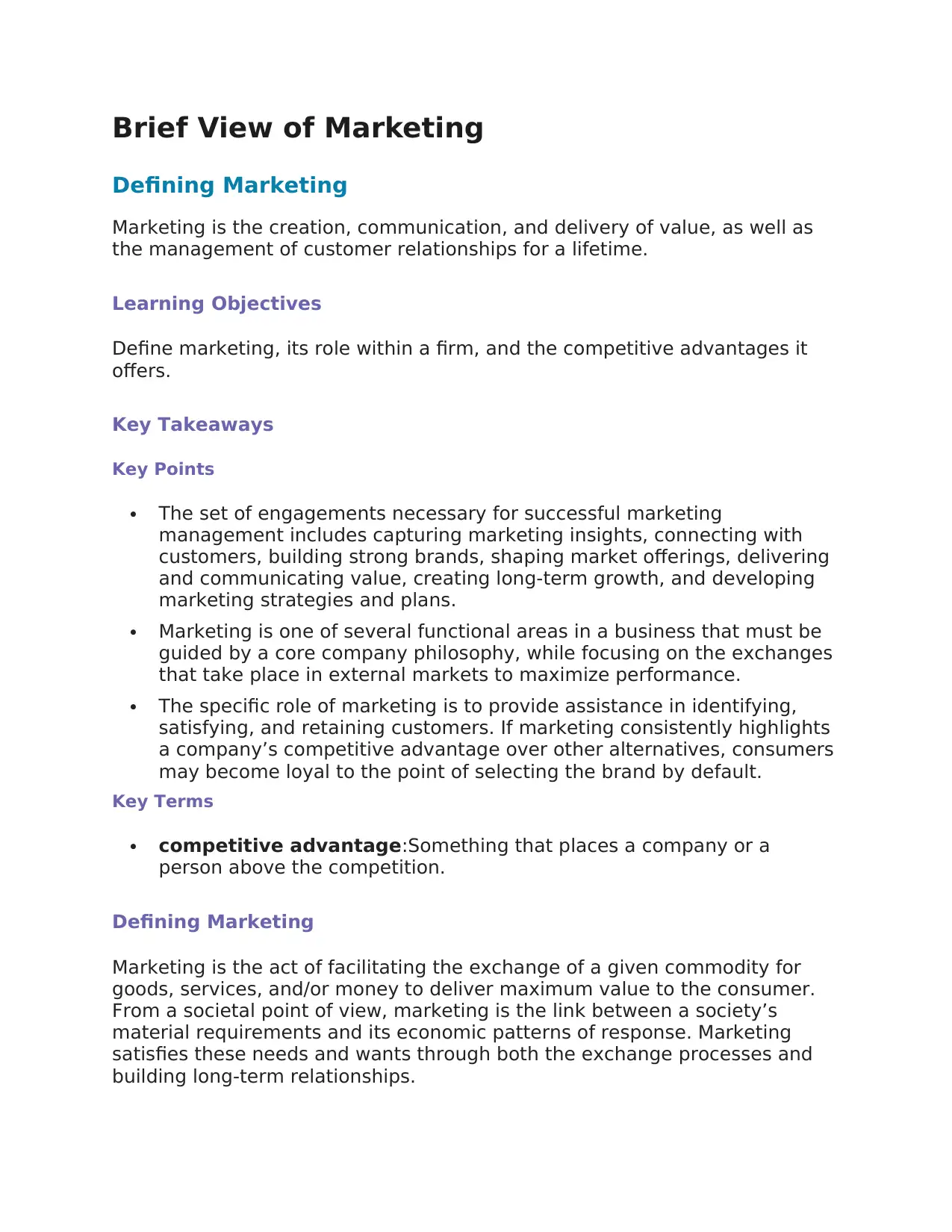
Brief View of Marketing
Defining Marketing
Marketing is the creation, communication, and delivery of value, as well as
the management of customer relationships for a lifetime.
Learning Objectives
Define marketing, its role within a firm, and the competitive advantages it
offers.
Key Takeaways
Key Points
The set of engagements necessary for successful marketing
management includes capturing marketing insights, connecting with
customers, building strong brands, shaping market offerings, delivering
and communicating value, creating long-term growth, and developing
marketing strategies and plans.
Marketing is one of several functional areas in a business that must be
guided by a core company philosophy, while focusing on the exchanges
that take place in external markets to maximize performance.
The specific role of marketing is to provide assistance in identifying,
satisfying, and retaining customers. If marketing consistently highlights
a company’s competitive advantage over other alternatives, consumers
may become loyal to the point of selecting the brand by default.
Key Terms
competitive advantage:Something that places a company or a
person above the competition.
Defining Marketing
Marketing is the act of facilitating the exchange of a given commodity for
goods, services, and/or money to deliver maximum value to the consumer.
From a societal point of view, marketing is the link between a society’s
material requirements and its economic patterns of response. Marketing
satisfies these needs and wants through both the exchange processes and
building long-term relationships.
Defining Marketing
Marketing is the creation, communication, and delivery of value, as well as
the management of customer relationships for a lifetime.
Learning Objectives
Define marketing, its role within a firm, and the competitive advantages it
offers.
Key Takeaways
Key Points
The set of engagements necessary for successful marketing
management includes capturing marketing insights, connecting with
customers, building strong brands, shaping market offerings, delivering
and communicating value, creating long-term growth, and developing
marketing strategies and plans.
Marketing is one of several functional areas in a business that must be
guided by a core company philosophy, while focusing on the exchanges
that take place in external markets to maximize performance.
The specific role of marketing is to provide assistance in identifying,
satisfying, and retaining customers. If marketing consistently highlights
a company’s competitive advantage over other alternatives, consumers
may become loyal to the point of selecting the brand by default.
Key Terms
competitive advantage:Something that places a company or a
person above the competition.
Defining Marketing
Marketing is the act of facilitating the exchange of a given commodity for
goods, services, and/or money to deliver maximum value to the consumer.
From a societal point of view, marketing is the link between a society’s
material requirements and its economic patterns of response. Marketing
satisfies these needs and wants through both the exchange processes and
building long-term relationships.
Paraphrase This Document
Need a fresh take? Get an instant paraphrase of this document with our AI Paraphraser
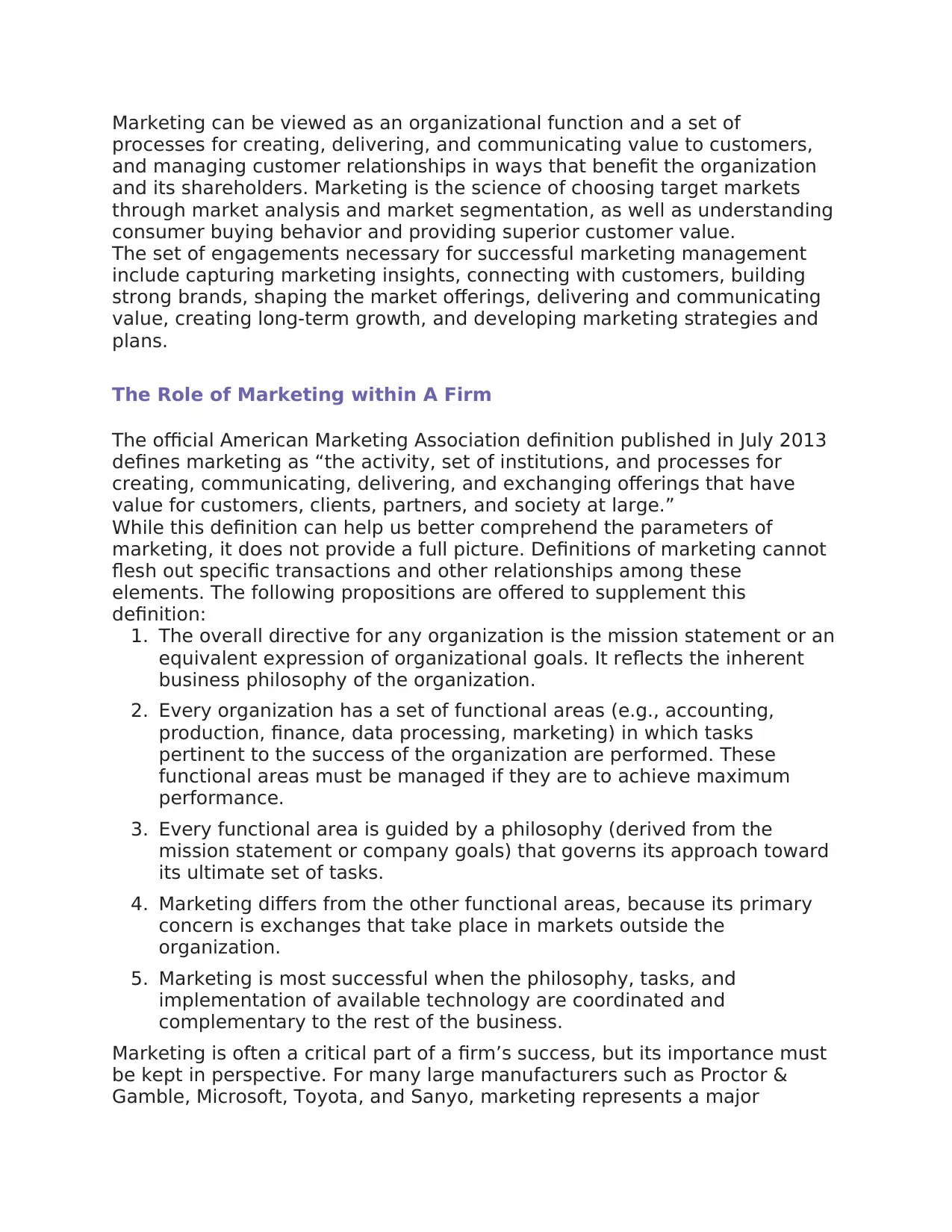
Marketing can be viewed as an organizational function and a set of
processes for creating, delivering, and communicating value to customers,
and managing customer relationships in ways that benefit the organization
and its shareholders. Marketing is the science of choosing target markets
through market analysis and market segmentation, as well as understanding
consumer buying behavior and providing superior customer value.
The set of engagements necessary for successful marketing management
include capturing marketing insights, connecting with customers, building
strong brands, shaping the market offerings, delivering and communicating
value, creating long-term growth, and developing marketing strategies and
plans.
The Role of Marketing within A Firm
The official American Marketing Association definition published in July 2013
defines marketing as “the activity, set of institutions, and processes for
creating, communicating, delivering, and exchanging offerings that have
value for customers, clients, partners, and society at large.”
While this definition can help us better comprehend the parameters of
marketing, it does not provide a full picture. Definitions of marketing cannot
flesh out specific transactions and other relationships among these
elements. The following propositions are offered to supplement this
definition:
1. The overall directive for any organization is the mission statement or an
equivalent expression of organizational goals. It reflects the inherent
business philosophy of the organization.
2. Every organization has a set of functional areas (e.g., accounting,
production, finance, data processing, marketing) in which tasks
pertinent to the success of the organization are performed. These
functional areas must be managed if they are to achieve maximum
performance.
3. Every functional area is guided by a philosophy (derived from the
mission statement or company goals) that governs its approach toward
its ultimate set of tasks.
4. Marketing differs from the other functional areas, because its primary
concern is exchanges that take place in markets outside the
organization.
5. Marketing is most successful when the philosophy, tasks, and
implementation of available technology are coordinated and
complementary to the rest of the business.
Marketing is often a critical part of a firm’s success, but its importance must
be kept in perspective. For many large manufacturers such as Proctor &
Gamble, Microsoft, Toyota, and Sanyo, marketing represents a major
processes for creating, delivering, and communicating value to customers,
and managing customer relationships in ways that benefit the organization
and its shareholders. Marketing is the science of choosing target markets
through market analysis and market segmentation, as well as understanding
consumer buying behavior and providing superior customer value.
The set of engagements necessary for successful marketing management
include capturing marketing insights, connecting with customers, building
strong brands, shaping the market offerings, delivering and communicating
value, creating long-term growth, and developing marketing strategies and
plans.
The Role of Marketing within A Firm
The official American Marketing Association definition published in July 2013
defines marketing as “the activity, set of institutions, and processes for
creating, communicating, delivering, and exchanging offerings that have
value for customers, clients, partners, and society at large.”
While this definition can help us better comprehend the parameters of
marketing, it does not provide a full picture. Definitions of marketing cannot
flesh out specific transactions and other relationships among these
elements. The following propositions are offered to supplement this
definition:
1. The overall directive for any organization is the mission statement or an
equivalent expression of organizational goals. It reflects the inherent
business philosophy of the organization.
2. Every organization has a set of functional areas (e.g., accounting,
production, finance, data processing, marketing) in which tasks
pertinent to the success of the organization are performed. These
functional areas must be managed if they are to achieve maximum
performance.
3. Every functional area is guided by a philosophy (derived from the
mission statement or company goals) that governs its approach toward
its ultimate set of tasks.
4. Marketing differs from the other functional areas, because its primary
concern is exchanges that take place in markets outside the
organization.
5. Marketing is most successful when the philosophy, tasks, and
implementation of available technology are coordinated and
complementary to the rest of the business.
Marketing is often a critical part of a firm’s success, but its importance must
be kept in perspective. For many large manufacturers such as Proctor &
Gamble, Microsoft, Toyota, and Sanyo, marketing represents a major
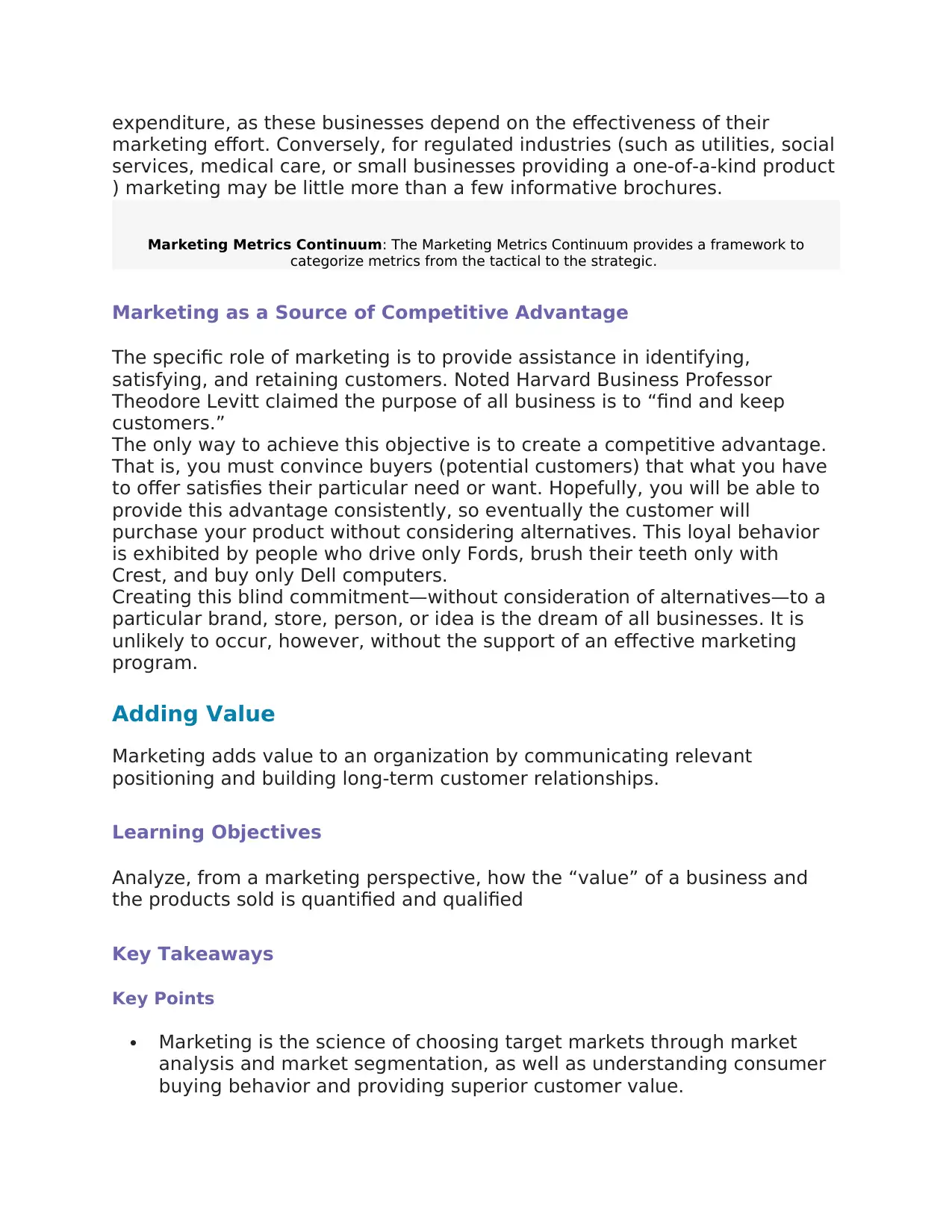
expenditure, as these businesses depend on the effectiveness of their
marketing effort. Conversely, for regulated industries (such as utilities, social
services, medical care, or small businesses providing a one-of-a-kind product
) marketing may be little more than a few informative brochures.
Marketing Metrics Continuum: The Marketing Metrics Continuum provides a framework to
categorize metrics from the tactical to the strategic.
Marketing as a Source of Competitive Advantage
The specific role of marketing is to provide assistance in identifying,
satisfying, and retaining customers. Noted Harvard Business Professor
Theodore Levitt claimed the purpose of all business is to “find and keep
customers.”
The only way to achieve this objective is to create a competitive advantage.
That is, you must convince buyers (potential customers) that what you have
to offer satisfies their particular need or want. Hopefully, you will be able to
provide this advantage consistently, so eventually the customer will
purchase your product without considering alternatives. This loyal behavior
is exhibited by people who drive only Fords, brush their teeth only with
Crest, and buy only Dell computers.
Creating this blind commitment—without consideration of alternatives—to a
particular brand, store, person, or idea is the dream of all businesses. It is
unlikely to occur, however, without the support of an effective marketing
program.
Adding Value
Marketing adds value to an organization by communicating relevant
positioning and building long-term customer relationships.
Learning Objectives
Analyze, from a marketing perspective, how the “value” of a business and
the products sold is quantified and qualified
Key Takeaways
Key Points
Marketing is the science of choosing target markets through market
analysis and market segmentation, as well as understanding consumer
buying behavior and providing superior customer value.
marketing effort. Conversely, for regulated industries (such as utilities, social
services, medical care, or small businesses providing a one-of-a-kind product
) marketing may be little more than a few informative brochures.
Marketing Metrics Continuum: The Marketing Metrics Continuum provides a framework to
categorize metrics from the tactical to the strategic.
Marketing as a Source of Competitive Advantage
The specific role of marketing is to provide assistance in identifying,
satisfying, and retaining customers. Noted Harvard Business Professor
Theodore Levitt claimed the purpose of all business is to “find and keep
customers.”
The only way to achieve this objective is to create a competitive advantage.
That is, you must convince buyers (potential customers) that what you have
to offer satisfies their particular need or want. Hopefully, you will be able to
provide this advantage consistently, so eventually the customer will
purchase your product without considering alternatives. This loyal behavior
is exhibited by people who drive only Fords, brush their teeth only with
Crest, and buy only Dell computers.
Creating this blind commitment—without consideration of alternatives—to a
particular brand, store, person, or idea is the dream of all businesses. It is
unlikely to occur, however, without the support of an effective marketing
program.
Adding Value
Marketing adds value to an organization by communicating relevant
positioning and building long-term customer relationships.
Learning Objectives
Analyze, from a marketing perspective, how the “value” of a business and
the products sold is quantified and qualified
Key Takeaways
Key Points
Marketing is the science of choosing target markets through market
analysis and market segmentation, as well as understanding consumer
buying behavior and providing superior customer value.
⊘ This is a preview!⊘
Do you want full access?
Subscribe today to unlock all pages.

Trusted by 1+ million students worldwide
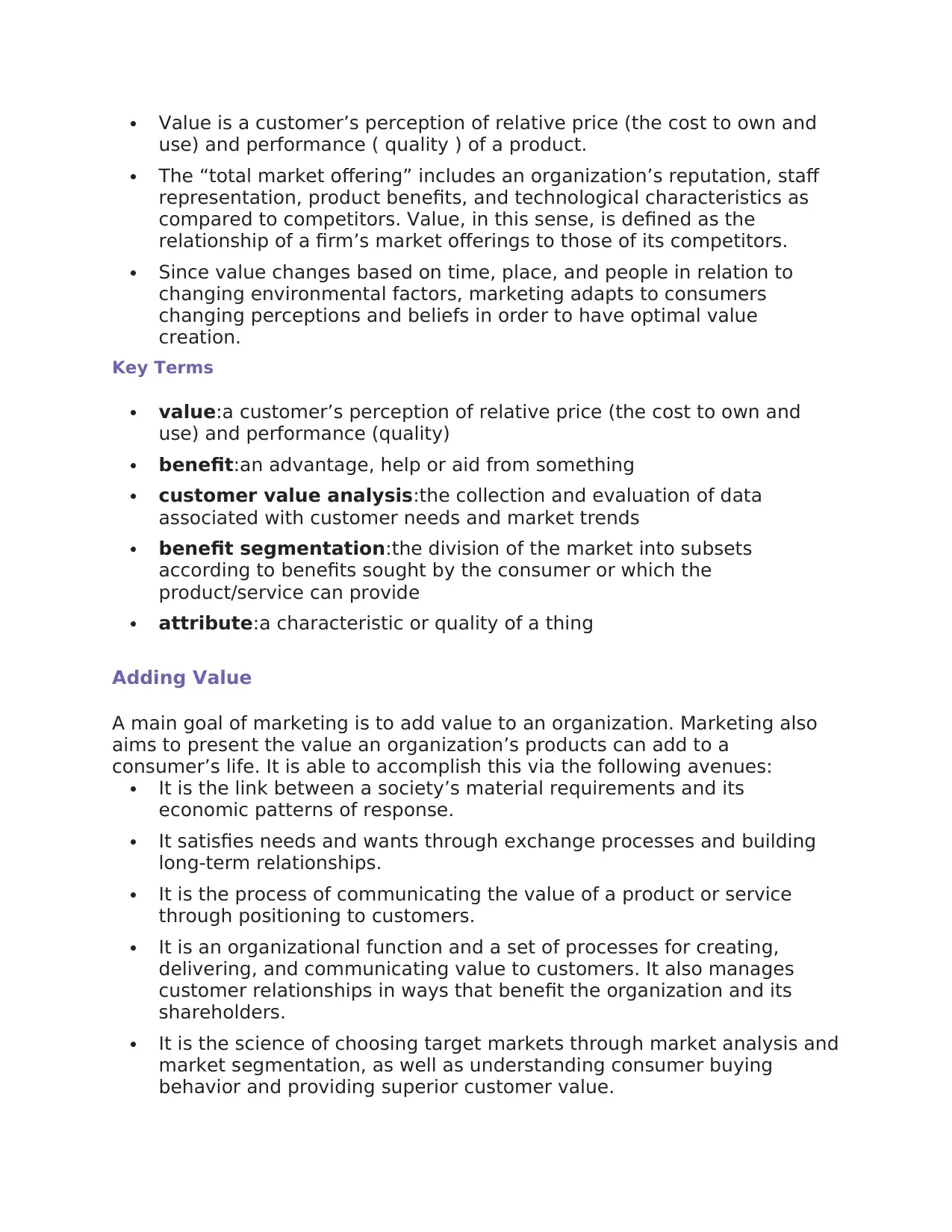
Value is a customer’s perception of relative price (the cost to own and
use) and performance ( quality ) of a product.
The “total market offering” includes an organization’s reputation, staff
representation, product benefits, and technological characteristics as
compared to competitors. Value, in this sense, is defined as the
relationship of a firm’s market offerings to those of its competitors.
Since value changes based on time, place, and people in relation to
changing environmental factors, marketing adapts to consumers
changing perceptions and beliefs in order to have optimal value
creation.
Key Terms
value:a customer’s perception of relative price (the cost to own and
use) and performance (quality)
benefit:an advantage, help or aid from something
customer value analysis:the collection and evaluation of data
associated with customer needs and market trends
benefit segmentation:the division of the market into subsets
according to benefits sought by the consumer or which the
product/service can provide
attribute:a characteristic or quality of a thing
Adding Value
A main goal of marketing is to add value to an organization. Marketing also
aims to present the value an organization’s products can add to a
consumer’s life. It is able to accomplish this via the following avenues:
It is the link between a society’s material requirements and its
economic patterns of response.
It satisfies needs and wants through exchange processes and building
long-term relationships.
It is the process of communicating the value of a product or service
through positioning to customers.
It is an organizational function and a set of processes for creating,
delivering, and communicating value to customers. It also manages
customer relationships in ways that benefit the organization and its
shareholders.
It is the science of choosing target markets through market analysis and
market segmentation, as well as understanding consumer buying
behavior and providing superior customer value.
use) and performance ( quality ) of a product.
The “total market offering” includes an organization’s reputation, staff
representation, product benefits, and technological characteristics as
compared to competitors. Value, in this sense, is defined as the
relationship of a firm’s market offerings to those of its competitors.
Since value changes based on time, place, and people in relation to
changing environmental factors, marketing adapts to consumers
changing perceptions and beliefs in order to have optimal value
creation.
Key Terms
value:a customer’s perception of relative price (the cost to own and
use) and performance (quality)
benefit:an advantage, help or aid from something
customer value analysis:the collection and evaluation of data
associated with customer needs and market trends
benefit segmentation:the division of the market into subsets
according to benefits sought by the consumer or which the
product/service can provide
attribute:a characteristic or quality of a thing
Adding Value
A main goal of marketing is to add value to an organization. Marketing also
aims to present the value an organization’s products can add to a
consumer’s life. It is able to accomplish this via the following avenues:
It is the link between a society’s material requirements and its
economic patterns of response.
It satisfies needs and wants through exchange processes and building
long-term relationships.
It is the process of communicating the value of a product or service
through positioning to customers.
It is an organizational function and a set of processes for creating,
delivering, and communicating value to customers. It also manages
customer relationships in ways that benefit the organization and its
shareholders.
It is the science of choosing target markets through market analysis and
market segmentation, as well as understanding consumer buying
behavior and providing superior customer value.
Paraphrase This Document
Need a fresh take? Get an instant paraphrase of this document with our AI Paraphraser
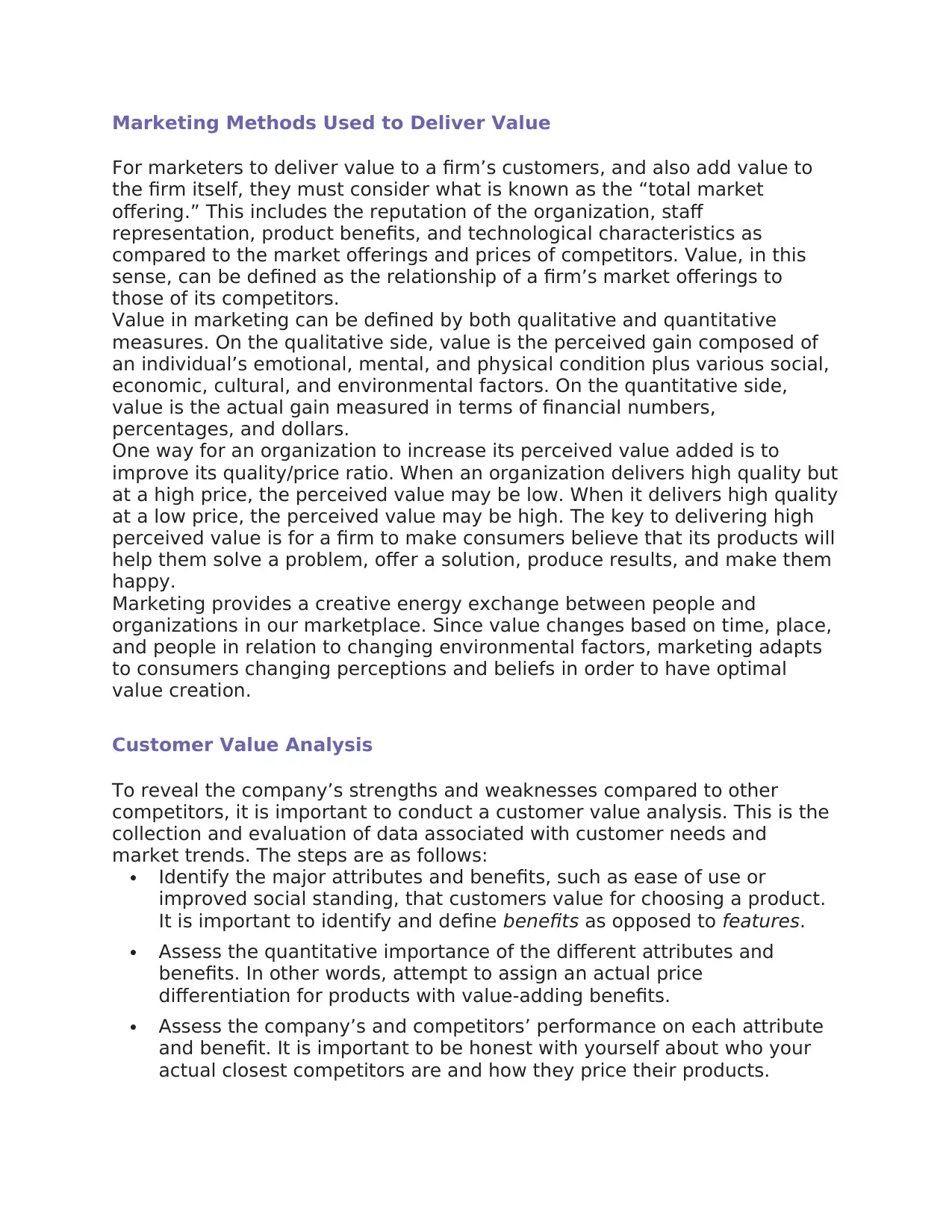
Marketing Methods Used to Deliver Value
For marketers to deliver value to a firm’s customers, and also add value to
the firm itself, they must consider what is known as the “total market
offering.” This includes the reputation of the organization, staff
representation, product benefits, and technological characteristics as
compared to the market offerings and prices of competitors. Value, in this
sense, can be defined as the relationship of a firm’s market offerings to
those of its competitors.
Value in marketing can be defined by both qualitative and quantitative
measures. On the qualitative side, value is the perceived gain composed of
an individual’s emotional, mental, and physical condition plus various social,
economic, cultural, and environmental factors. On the quantitative side,
value is the actual gain measured in terms of financial numbers,
percentages, and dollars.
One way for an organization to increase its perceived value added is to
improve its quality/price ratio. When an organization delivers high quality but
at a high price, the perceived value may be low. When it delivers high quality
at a low price, the perceived value may be high. The key to delivering high
perceived value is for a firm to make consumers believe that its products will
help them solve a problem, offer a solution, produce results, and make them
happy.
Marketing provides a creative energy exchange between people and
organizations in our marketplace. Since value changes based on time, place,
and people in relation to changing environmental factors, marketing adapts
to consumers changing perceptions and beliefs in order to have optimal
value creation.
Customer Value Analysis
To reveal the company’s strengths and weaknesses compared to other
competitors, it is important to conduct a customer value analysis. This is the
collection and evaluation of data associated with customer needs and
market trends. The steps are as follows:
Identify the major attributes and benefits, such as ease of use or
improved social standing, that customers value for choosing a product.
It is important to identify and define benefits as opposed to features.
Assess the quantitative importance of the different attributes and
benefits. In other words, attempt to assign an actual price
differentiation for products with value-adding benefits.
Assess the company’s and competitors’ performance on each attribute
and benefit. It is important to be honest with yourself about who your
actual closest competitors are and how they price their products.
For marketers to deliver value to a firm’s customers, and also add value to
the firm itself, they must consider what is known as the “total market
offering.” This includes the reputation of the organization, staff
representation, product benefits, and technological characteristics as
compared to the market offerings and prices of competitors. Value, in this
sense, can be defined as the relationship of a firm’s market offerings to
those of its competitors.
Value in marketing can be defined by both qualitative and quantitative
measures. On the qualitative side, value is the perceived gain composed of
an individual’s emotional, mental, and physical condition plus various social,
economic, cultural, and environmental factors. On the quantitative side,
value is the actual gain measured in terms of financial numbers,
percentages, and dollars.
One way for an organization to increase its perceived value added is to
improve its quality/price ratio. When an organization delivers high quality but
at a high price, the perceived value may be low. When it delivers high quality
at a low price, the perceived value may be high. The key to delivering high
perceived value is for a firm to make consumers believe that its products will
help them solve a problem, offer a solution, produce results, and make them
happy.
Marketing provides a creative energy exchange between people and
organizations in our marketplace. Since value changes based on time, place,
and people in relation to changing environmental factors, marketing adapts
to consumers changing perceptions and beliefs in order to have optimal
value creation.
Customer Value Analysis
To reveal the company’s strengths and weaknesses compared to other
competitors, it is important to conduct a customer value analysis. This is the
collection and evaluation of data associated with customer needs and
market trends. The steps are as follows:
Identify the major attributes and benefits, such as ease of use or
improved social standing, that customers value for choosing a product.
It is important to identify and define benefits as opposed to features.
Assess the quantitative importance of the different attributes and
benefits. In other words, attempt to assign an actual price
differentiation for products with value-adding benefits.
Assess the company’s and competitors’ performance on each attribute
and benefit. It is important to be honest with yourself about who your
actual closest competitors are and how they price their products.
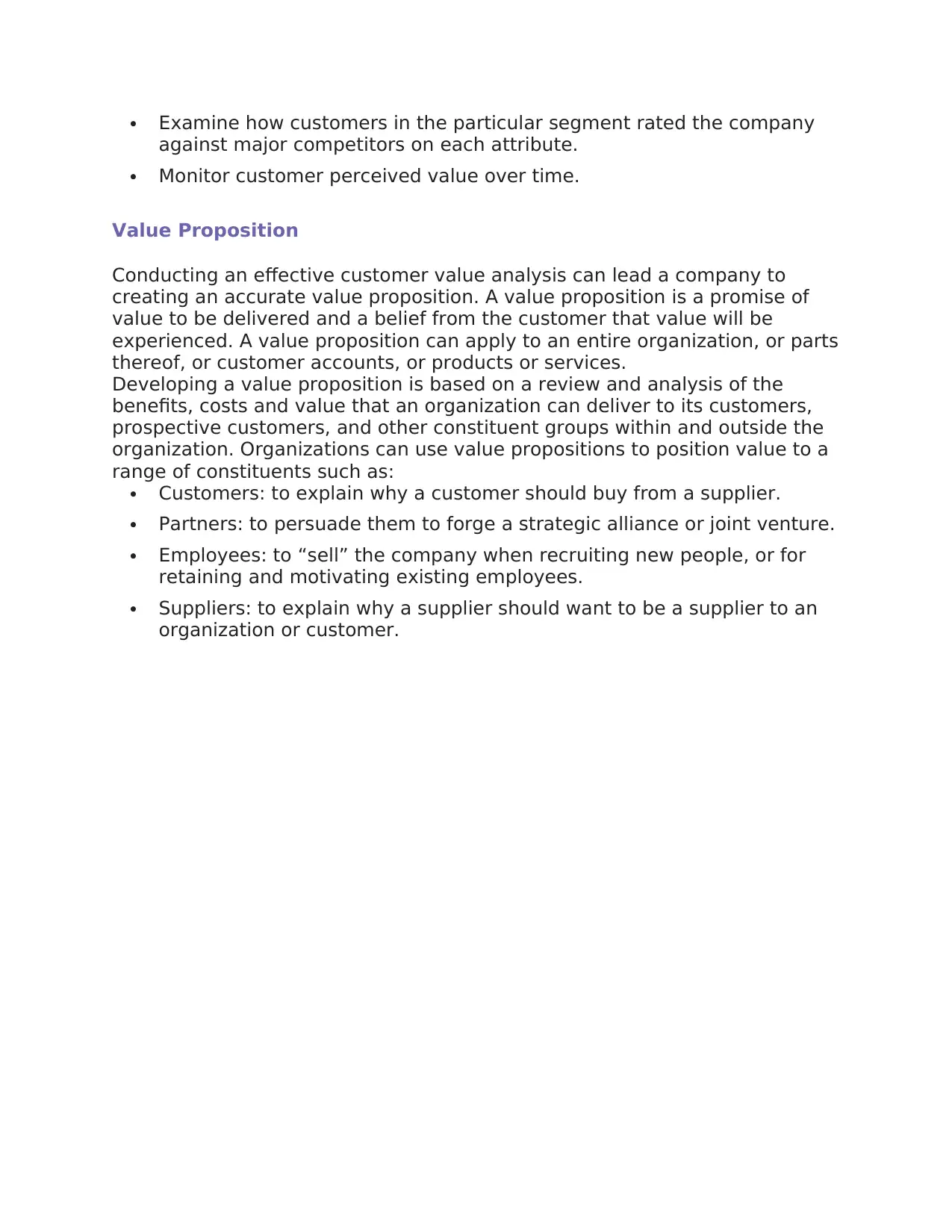
Examine how customers in the particular segment rated the company
against major competitors on each attribute.
Monitor customer perceived value over time.
Value Proposition
Conducting an effective customer value analysis can lead a company to
creating an accurate value proposition. A value proposition is a promise of
value to be delivered and a belief from the customer that value will be
experienced. A value proposition can apply to an entire organization, or parts
thereof, or customer accounts, or products or services.
Developing a value proposition is based on a review and analysis of the
benefits, costs and value that an organization can deliver to its customers,
prospective customers, and other constituent groups within and outside the
organization. Organizations can use value propositions to position value to a
range of constituents such as:
Customers: to explain why a customer should buy from a supplier.
Partners: to persuade them to forge a strategic alliance or joint venture.
Employees: to “sell” the company when recruiting new people, or for
retaining and motivating existing employees.
Suppliers: to explain why a supplier should want to be a supplier to an
organization or customer.
against major competitors on each attribute.
Monitor customer perceived value over time.
Value Proposition
Conducting an effective customer value analysis can lead a company to
creating an accurate value proposition. A value proposition is a promise of
value to be delivered and a belief from the customer that value will be
experienced. A value proposition can apply to an entire organization, or parts
thereof, or customer accounts, or products or services.
Developing a value proposition is based on a review and analysis of the
benefits, costs and value that an organization can deliver to its customers,
prospective customers, and other constituent groups within and outside the
organization. Organizations can use value propositions to position value to a
range of constituents such as:
Customers: to explain why a customer should buy from a supplier.
Partners: to persuade them to forge a strategic alliance or joint venture.
Employees: to “sell” the company when recruiting new people, or for
retaining and motivating existing employees.
Suppliers: to explain why a supplier should want to be a supplier to an
organization or customer.
⊘ This is a preview!⊘
Do you want full access?
Subscribe today to unlock all pages.

Trusted by 1+ million students worldwide
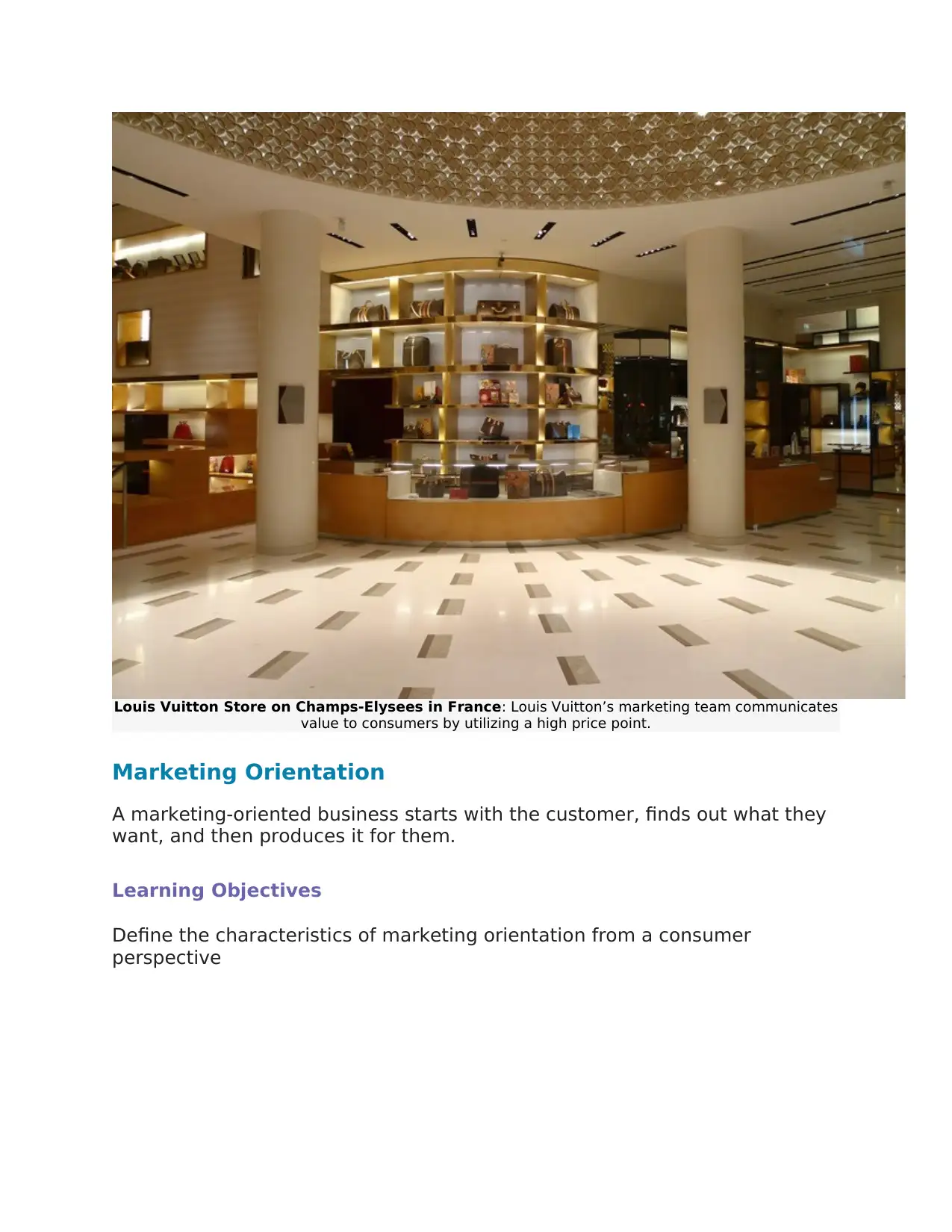
Louis Vuitton Store on Champs-Elysees in France: Louis Vuitton’s marketing team communicates
value to consumers by utilizing a high price point.
Marketing Orientation
A marketing-oriented business starts with the customer, finds out what they
want, and then produces it for them.
Learning Objectives
Define the characteristics of marketing orientation from a consumer
perspective
value to consumers by utilizing a high price point.
Marketing Orientation
A marketing-oriented business starts with the customer, finds out what they
want, and then produces it for them.
Learning Objectives
Define the characteristics of marketing orientation from a consumer
perspective
Paraphrase This Document
Need a fresh take? Get an instant paraphrase of this document with our AI Paraphraser
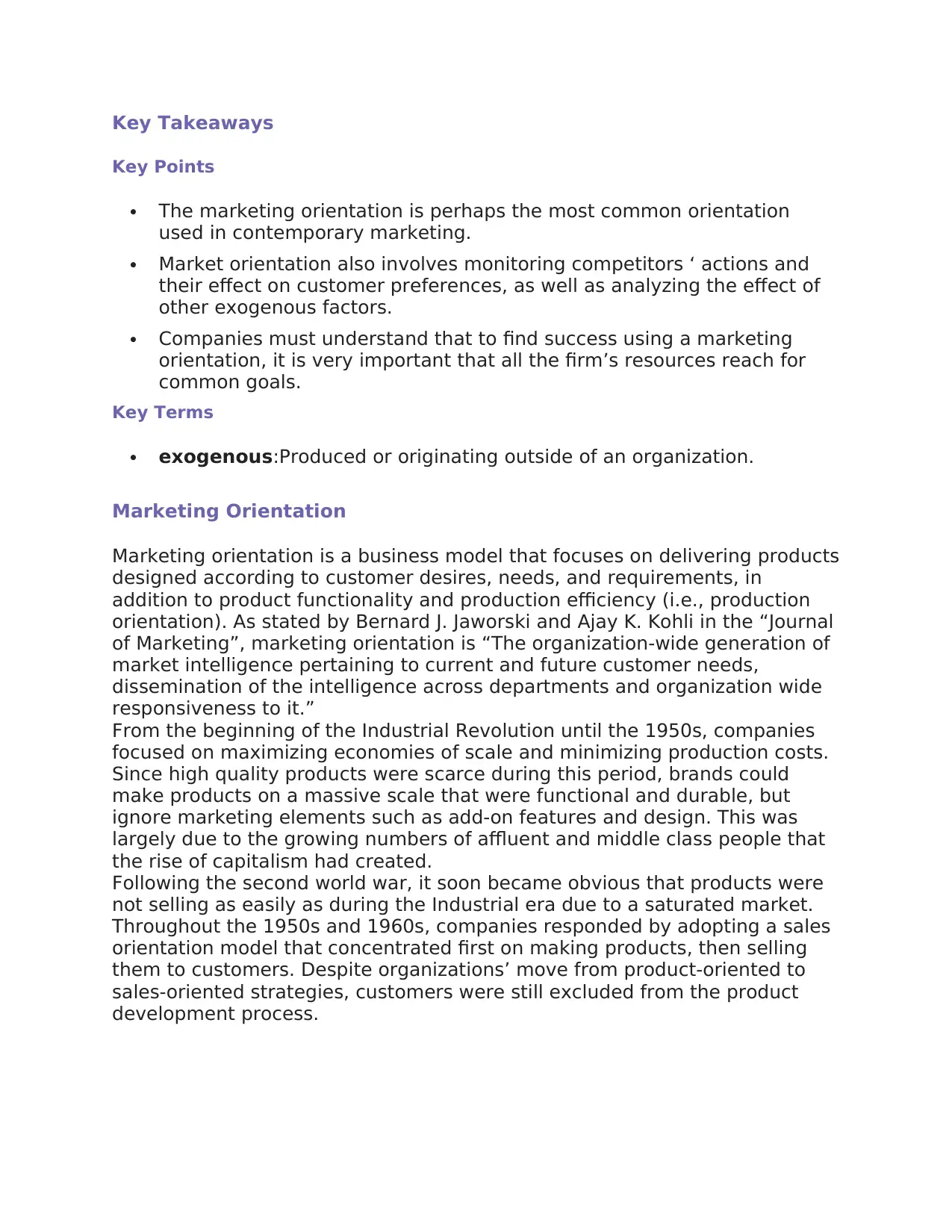
Key Takeaways
Key Points
The marketing orientation is perhaps the most common orientation
used in contemporary marketing.
Market orientation also involves monitoring competitors ‘ actions and
their effect on customer preferences, as well as analyzing the effect of
other exogenous factors.
Companies must understand that to find success using a marketing
orientation, it is very important that all the firm’s resources reach for
common goals.
Key Terms
exogenous:Produced or originating outside of an organization.
Marketing Orientation
Marketing orientation is a business model that focuses on delivering products
designed according to customer desires, needs, and requirements, in
addition to product functionality and production efficiency (i.e., production
orientation). As stated by Bernard J. Jaworski and Ajay K. Kohli in the “Journal
of Marketing”, marketing orientation is “The organization-wide generation of
market intelligence pertaining to current and future customer needs,
dissemination of the intelligence across departments and organization wide
responsiveness to it.”
From the beginning of the Industrial Revolution until the 1950s, companies
focused on maximizing economies of scale and minimizing production costs.
Since high quality products were scarce during this period, brands could
make products on a massive scale that were functional and durable, but
ignore marketing elements such as add-on features and design. This was
largely due to the growing numbers of affluent and middle class people that
the rise of capitalism had created.
Following the second world war, it soon became obvious that products were
not selling as easily as during the Industrial era due to a saturated market.
Throughout the 1950s and 1960s, companies responded by adopting a sales
orientation model that concentrated first on making products, then selling
them to customers. Despite organizations’ move from product-oriented to
sales-oriented strategies, customers were still excluded from the product
development process.
Key Points
The marketing orientation is perhaps the most common orientation
used in contemporary marketing.
Market orientation also involves monitoring competitors ‘ actions and
their effect on customer preferences, as well as analyzing the effect of
other exogenous factors.
Companies must understand that to find success using a marketing
orientation, it is very important that all the firm’s resources reach for
common goals.
Key Terms
exogenous:Produced or originating outside of an organization.
Marketing Orientation
Marketing orientation is a business model that focuses on delivering products
designed according to customer desires, needs, and requirements, in
addition to product functionality and production efficiency (i.e., production
orientation). As stated by Bernard J. Jaworski and Ajay K. Kohli in the “Journal
of Marketing”, marketing orientation is “The organization-wide generation of
market intelligence pertaining to current and future customer needs,
dissemination of the intelligence across departments and organization wide
responsiveness to it.”
From the beginning of the Industrial Revolution until the 1950s, companies
focused on maximizing economies of scale and minimizing production costs.
Since high quality products were scarce during this period, brands could
make products on a massive scale that were functional and durable, but
ignore marketing elements such as add-on features and design. This was
largely due to the growing numbers of affluent and middle class people that
the rise of capitalism had created.
Following the second world war, it soon became obvious that products were
not selling as easily as during the Industrial era due to a saturated market.
Throughout the 1950s and 1960s, companies responded by adopting a sales
orientation model that concentrated first on making products, then selling
them to customers. Despite organizations’ move from product-oriented to
sales-oriented strategies, customers were still excluded from the product
development process.
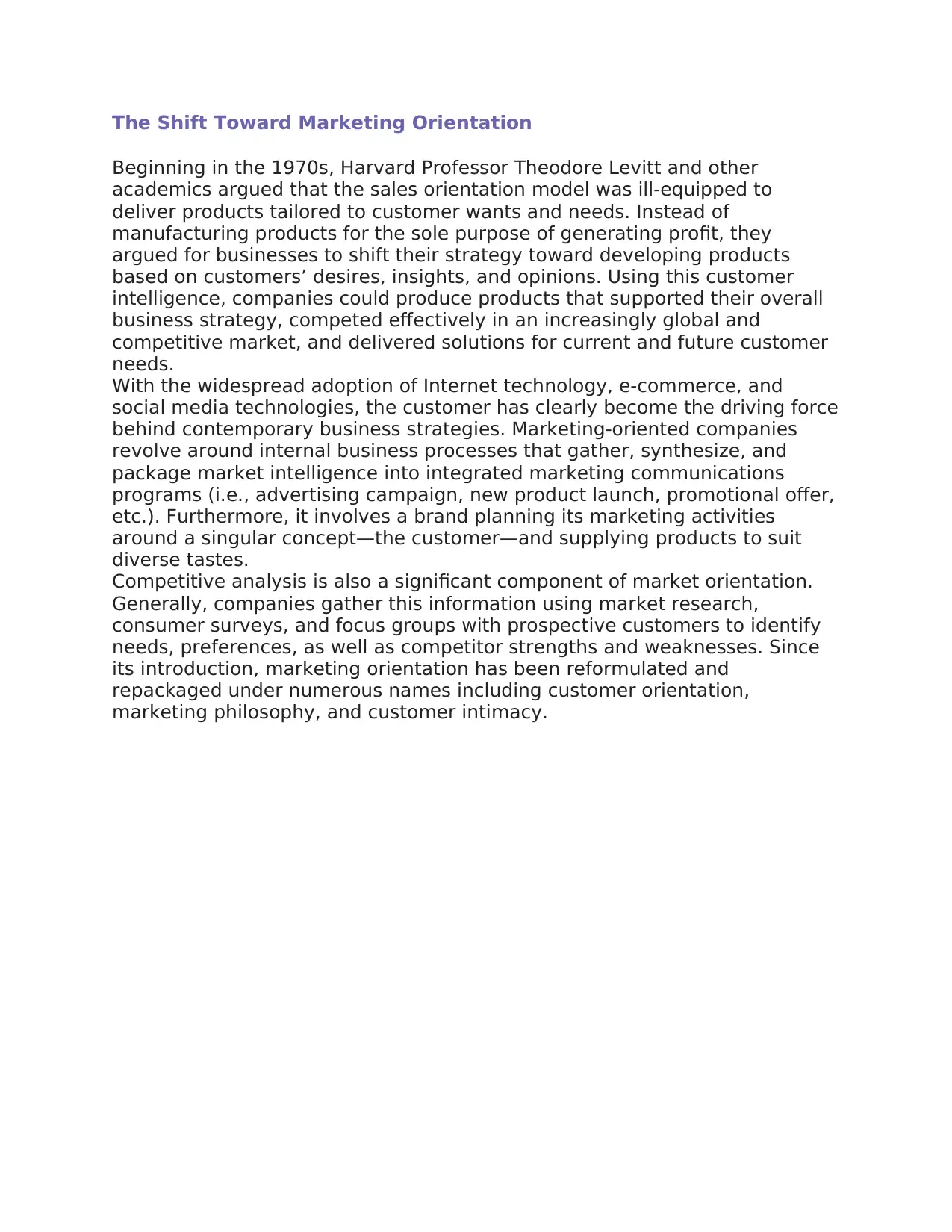
The Shift Toward Marketing Orientation
Beginning in the 1970s, Harvard Professor Theodore Levitt and other
academics argued that the sales orientation model was ill-equipped to
deliver products tailored to customer wants and needs. Instead of
manufacturing products for the sole purpose of generating profit, they
argued for businesses to shift their strategy toward developing products
based on customers’ desires, insights, and opinions. Using this customer
intelligence, companies could produce products that supported their overall
business strategy, competed effectively in an increasingly global and
competitive market, and delivered solutions for current and future customer
needs.
With the widespread adoption of Internet technology, e-commerce, and
social media technologies, the customer has clearly become the driving force
behind contemporary business strategies. Marketing-oriented companies
revolve around internal business processes that gather, synthesize, and
package market intelligence into integrated marketing communications
programs (i.e., advertising campaign, new product launch, promotional offer,
etc.). Furthermore, it involves a brand planning its marketing activities
around a singular concept—the customer—and supplying products to suit
diverse tastes.
Competitive analysis is also a significant component of market orientation.
Generally, companies gather this information using market research,
consumer surveys, and focus groups with prospective customers to identify
needs, preferences, as well as competitor strengths and weaknesses. Since
its introduction, marketing orientation has been reformulated and
repackaged under numerous names including customer orientation,
marketing philosophy, and customer intimacy.
Beginning in the 1970s, Harvard Professor Theodore Levitt and other
academics argued that the sales orientation model was ill-equipped to
deliver products tailored to customer wants and needs. Instead of
manufacturing products for the sole purpose of generating profit, they
argued for businesses to shift their strategy toward developing products
based on customers’ desires, insights, and opinions. Using this customer
intelligence, companies could produce products that supported their overall
business strategy, competed effectively in an increasingly global and
competitive market, and delivered solutions for current and future customer
needs.
With the widespread adoption of Internet technology, e-commerce, and
social media technologies, the customer has clearly become the driving force
behind contemporary business strategies. Marketing-oriented companies
revolve around internal business processes that gather, synthesize, and
package market intelligence into integrated marketing communications
programs (i.e., advertising campaign, new product launch, promotional offer,
etc.). Furthermore, it involves a brand planning its marketing activities
around a singular concept—the customer—and supplying products to suit
diverse tastes.
Competitive analysis is also a significant component of market orientation.
Generally, companies gather this information using market research,
consumer surveys, and focus groups with prospective customers to identify
needs, preferences, as well as competitor strengths and weaknesses. Since
its introduction, marketing orientation has been reformulated and
repackaged under numerous names including customer orientation,
marketing philosophy, and customer intimacy.
⊘ This is a preview!⊘
Do you want full access?
Subscribe today to unlock all pages.

Trusted by 1+ million students worldwide
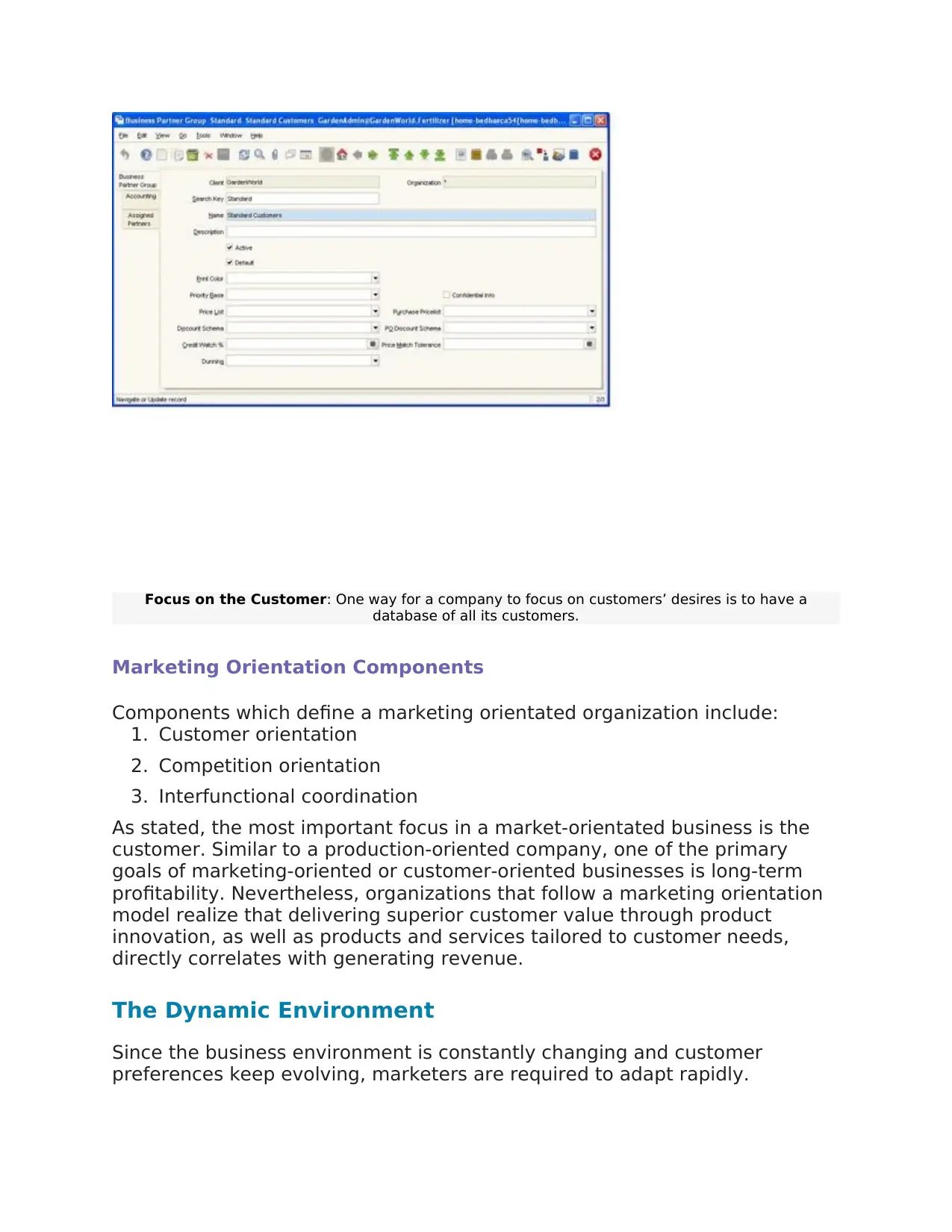
Focus on the Customer: One way for a company to focus on customers’ desires is to have a
database of all its customers.
Marketing Orientation Components
Components which define a marketing orientated organization include:
1. Customer orientation
2. Competition orientation
3. Interfunctional coordination
As stated, the most important focus in a market-orientated business is the
customer. Similar to a production-oriented company, one of the primary
goals of marketing-oriented or customer-oriented businesses is long-term
profitability. Nevertheless, organizations that follow a marketing orientation
model realize that delivering superior customer value through product
innovation, as well as products and services tailored to customer needs,
directly correlates with generating revenue.
The Dynamic Environment
Since the business environment is constantly changing and customer
preferences keep evolving, marketers are required to adapt rapidly.
database of all its customers.
Marketing Orientation Components
Components which define a marketing orientated organization include:
1. Customer orientation
2. Competition orientation
3. Interfunctional coordination
As stated, the most important focus in a market-orientated business is the
customer. Similar to a production-oriented company, one of the primary
goals of marketing-oriented or customer-oriented businesses is long-term
profitability. Nevertheless, organizations that follow a marketing orientation
model realize that delivering superior customer value through product
innovation, as well as products and services tailored to customer needs,
directly correlates with generating revenue.
The Dynamic Environment
Since the business environment is constantly changing and customer
preferences keep evolving, marketers are required to adapt rapidly.
Paraphrase This Document
Need a fresh take? Get an instant paraphrase of this document with our AI Paraphraser
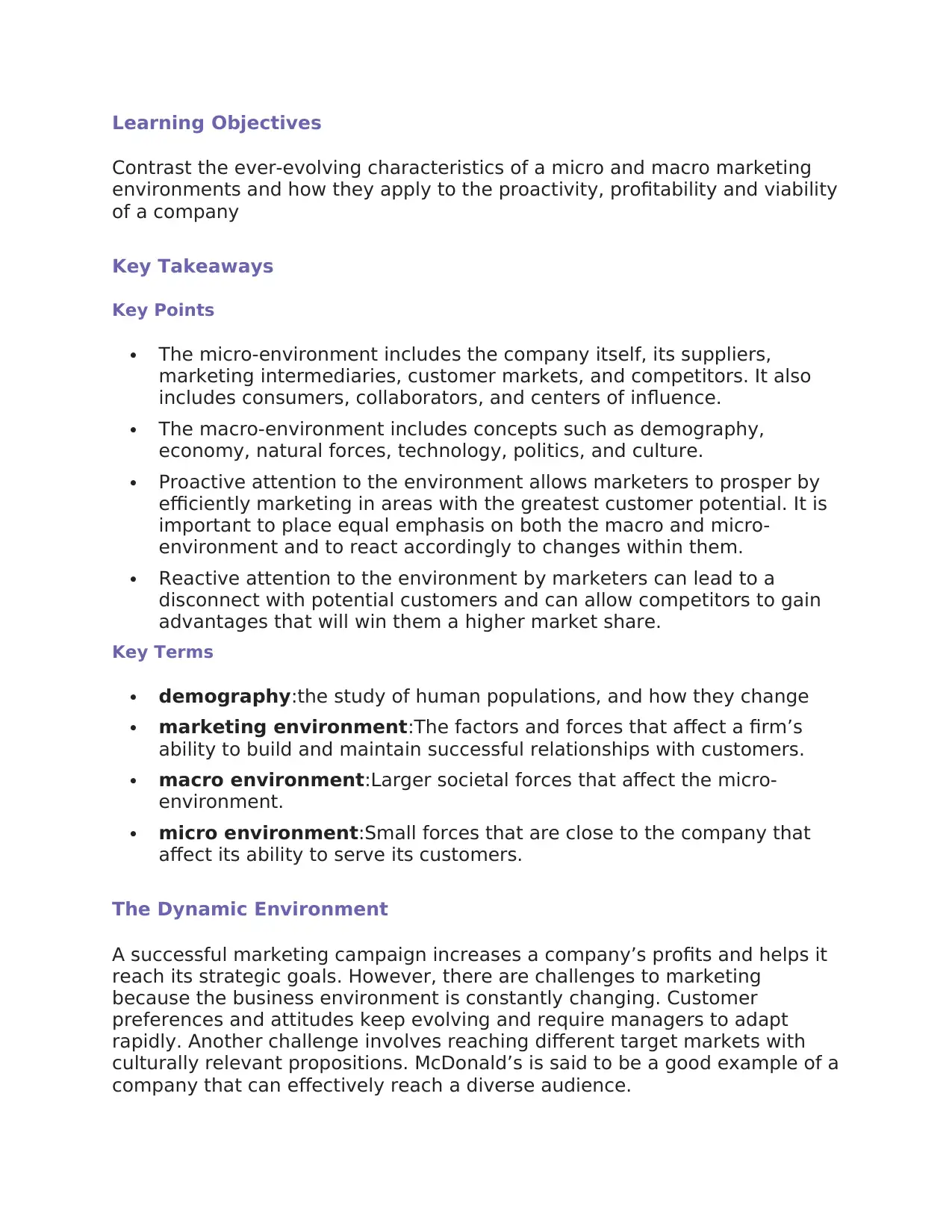
Learning Objectives
Contrast the ever-evolving characteristics of a micro and macro marketing
environments and how they apply to the proactivity, profitability and viability
of a company
Key Takeaways
Key Points
The micro-environment includes the company itself, its suppliers,
marketing intermediaries, customer markets, and competitors. It also
includes consumers, collaborators, and centers of influence.
The macro-environment includes concepts such as demography,
economy, natural forces, technology, politics, and culture.
Proactive attention to the environment allows marketers to prosper by
efficiently marketing in areas with the greatest customer potential. It is
important to place equal emphasis on both the macro and micro-
environment and to react accordingly to changes within them.
Reactive attention to the environment by marketers can lead to a
disconnect with potential customers and can allow competitors to gain
advantages that will win them a higher market share.
Key Terms
demography:the study of human populations, and how they change
marketing environment:The factors and forces that affect a firm’s
ability to build and maintain successful relationships with customers.
macro environment:Larger societal forces that affect the micro-
environment.
micro environment:Small forces that are close to the company that
affect its ability to serve its customers.
The Dynamic Environment
A successful marketing campaign increases a company’s profits and helps it
reach its strategic goals. However, there are challenges to marketing
because the business environment is constantly changing. Customer
preferences and attitudes keep evolving and require managers to adapt
rapidly. Another challenge involves reaching different target markets with
culturally relevant propositions. McDonald’s is said to be a good example of a
company that can effectively reach a diverse audience.
Contrast the ever-evolving characteristics of a micro and macro marketing
environments and how they apply to the proactivity, profitability and viability
of a company
Key Takeaways
Key Points
The micro-environment includes the company itself, its suppliers,
marketing intermediaries, customer markets, and competitors. It also
includes consumers, collaborators, and centers of influence.
The macro-environment includes concepts such as demography,
economy, natural forces, technology, politics, and culture.
Proactive attention to the environment allows marketers to prosper by
efficiently marketing in areas with the greatest customer potential. It is
important to place equal emphasis on both the macro and micro-
environment and to react accordingly to changes within them.
Reactive attention to the environment by marketers can lead to a
disconnect with potential customers and can allow competitors to gain
advantages that will win them a higher market share.
Key Terms
demography:the study of human populations, and how they change
marketing environment:The factors and forces that affect a firm’s
ability to build and maintain successful relationships with customers.
macro environment:Larger societal forces that affect the micro-
environment.
micro environment:Small forces that are close to the company that
affect its ability to serve its customers.
The Dynamic Environment
A successful marketing campaign increases a company’s profits and helps it
reach its strategic goals. However, there are challenges to marketing
because the business environment is constantly changing. Customer
preferences and attitudes keep evolving and require managers to adapt
rapidly. Another challenge involves reaching different target markets with
culturally relevant propositions. McDonald’s is said to be a good example of a
company that can effectively reach a diverse audience.
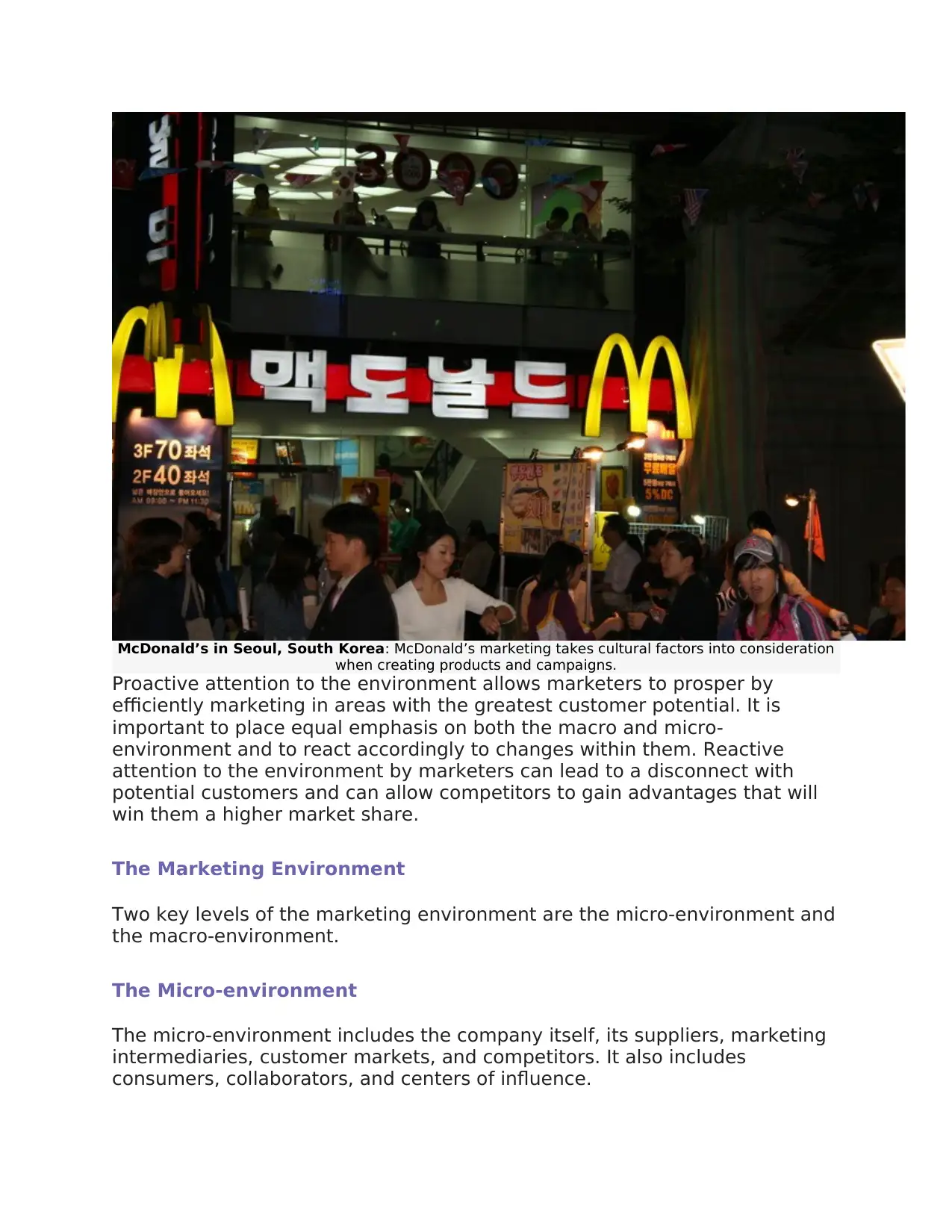
McDonald’s in Seoul, South Korea: McDonald’s marketing takes cultural factors into consideration
when creating products and campaigns.
Proactive attention to the environment allows marketers to prosper by
efficiently marketing in areas with the greatest customer potential. It is
important to place equal emphasis on both the macro and micro-
environment and to react accordingly to changes within them. Reactive
attention to the environment by marketers can lead to a disconnect with
potential customers and can allow competitors to gain advantages that will
win them a higher market share.
The Marketing Environment
Two key levels of the marketing environment are the micro-environment and
the macro-environment.
The Micro-environment
The micro-environment includes the company itself, its suppliers, marketing
intermediaries, customer markets, and competitors. It also includes
consumers, collaborators, and centers of influence.
when creating products and campaigns.
Proactive attention to the environment allows marketers to prosper by
efficiently marketing in areas with the greatest customer potential. It is
important to place equal emphasis on both the macro and micro-
environment and to react accordingly to changes within them. Reactive
attention to the environment by marketers can lead to a disconnect with
potential customers and can allow competitors to gain advantages that will
win them a higher market share.
The Marketing Environment
Two key levels of the marketing environment are the micro-environment and
the macro-environment.
The Micro-environment
The micro-environment includes the company itself, its suppliers, marketing
intermediaries, customer markets, and competitors. It also includes
consumers, collaborators, and centers of influence.
⊘ This is a preview!⊘
Do you want full access?
Subscribe today to unlock all pages.

Trusted by 1+ million students worldwide
1 out of 18
Related Documents
Your All-in-One AI-Powered Toolkit for Academic Success.
+13062052269
info@desklib.com
Available 24*7 on WhatsApp / Email
![[object Object]](/_next/static/media/star-bottom.7253800d.svg)
Unlock your academic potential
Copyright © 2020–2025 A2Z Services. All Rights Reserved. Developed and managed by ZUCOL.





